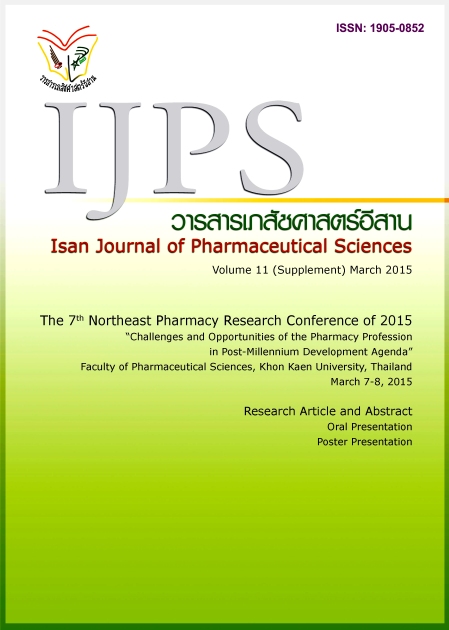Time to progression of end-stage renal disease in type 2 diabetic patients : a retrospective study from electronic database
Main Article Content
Abstract
Introduction: There has been an increasing of end-stage renal disease in patients with type 2 diabetes. The K/DOQI 2002 guideline showed the year until kidney failure based on level of GFR and rate of GFR decline. Objective: The study was aimed to show the table of time in progression of end-stage renal disease in type 2 diabetic patients. Materials and Methods: The data was retrospectively collected from the hospital retrospective electronic database between January, 2003 to December, 2012 in patients with type 2 diabetes. The result revealed at least two separated value of serum creatinine for at least 12 month period to calculate the estimated GFR by the CKD-EPI equation, Therefore, the first value of GFRs which was less than 15 ml/min/1.73m2 and the second value was gone back and calculated the time as year of end-stage renal disease back to the second GFR and calculate the declined GFR per year. Results: Total of 31,457 type 2 diabetic patients were recruited while 635 patients were reported with ESRD. Most of them were female (64.57%). At the time of first GFR found, the mean GFR was 10.50 ml/min/1.73m2. At the time of second GFR found, the mean age was 61.15 years old, mean GFR was 35.08 ml/min/1.73m2. The mean rate of decline in GFR was 7.59 ml/min/1.73m2/year within mean 3.24 years. Conclusion: The patients with type 2 diabetes older than 60 years old, the mean rate of decline in GFR was 7.59 ml/min/1.73m2/year, so fast. Therefore, prevention of kidney as fast until diagnosis of type 2 diabetes is the best way.
Article Details
In the case that some parts are used by others The author must Confirm that obtaining permission to use some of the original authors. And must attach evidence That the permission has been included
References
Alwakeel JS, Isnani AC, Alsuwaida A, et al. Factors affecting the progression of diabetic nephropathy and its Complications: a single-center experience in Saudi Arabia. Ann Saudi Med 2011; 31(3): 236-242.
Chobanian AV, Bakris GL, Black HR, et al. Seventh report of the Joint National Committee on Prevention, Detection, Evaluation, and Treatment of High Blood Pressure. Hypertension2003; 42(6): 1206 - 1252.
Collins G and Altman D. Predicting the risk of chronic kidney disease in the UK: an evaluation of QKidney® scores using a primary care database. Br J Gen Pract 2012; doi:10.3399/bjgp12X636065.
Hsu CY, Iribarren C, McCulloch CE, Darbinian J and Go AS. Risk Factors for End-Stage Renal Disease 25-Year Follow-up. Arch Intern Med 2009; 169(4): 342-350.
Johnson ES, Smith DH, Thorp ML, Yang X and Juhaeri J. Predicting the risk of end-stage renal disease in the population-based setting: a retrospective case-control study. BMC Nephrology 2011; 12: 7.
K/DOQI Clinical Practice Guidelines for Chronic Kidney Disease: Evaluation, Classification, and Stratification. Am J Kidney Dis 2002; 39(suppl1): S1-S266.
Keane WF, Brenner BM, Zeeuw DD, et al. The risk of developing end-stage renal disease in patients with type 2 diabetes and nephropathy: The RENAAL Study. Kidney International 2003; 63:1499-1507.
Leehey DJ, Kramer H, Daoud TM, Chatha MP and Isreb MA. Progression of kidney disease in type 2 diabetes-beyond blood pressure control: an observational study. BMC Nephrology doi:10.1186/1471-2369-6-8.
National Health Security Office. Management of Chronic Kidney Disease Clinic Fund. In: Handbook of management of Nation Health Security Fund 2012. 1st ed. Bangkok, Thailand. 2012.
Villar M, Remomtet L, Labeeuw M and Ecochard R. Effect of Age, Gender, and Diabetes on Excess Death In End-Stage Renal Failure. J Am Soc Nephrol 2007; 18: 2125-2134.


